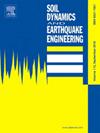Seismic vulnerability analysis of utility tunnel with oblique incidence of SV waves based on IDA method in horizontal non-homogeneous field
IF 4.6
2区 工程技术
Q1 ENGINEERING, GEOLOGICAL
引用次数: 0
Abstract
A utility tunnel is an infrastructure that consolidates multiple municipal pipeline systems into a shared underground passage. As long linear structures inevitably cross different soils, this paper aims to accurately assess the seismic damage to a shallow-buried utility tunnel in a non-homogeneous zone by employing a viscous-spring artificial boundary and deriving the corresponding nodal force equations. The three-dimensional model of the utility tunnel-soil system is established using finite element software, and a plug-in is developed to simulate the three-dimensional oblique incidence of SV waves with a horizontal non-homogeneous field. In this study, the maximum interstory displacement angle of the utility tunnel is used as the damage indicator. Analysis of structural vulnerability based on IDA method using PGA as an indicator of seismic wave intensity, which considers the angle of oblique incidence of SV waves, the type of seismic waves, and the influence of the non-homogeneous field on the seismic performance of the utility tunnel. The results indicate that the failure probability of the utility tunnel in different soil types increases with the incident angle and PGA. Additionally, the failure probability under the pulse wave is higher than that under the non-pulse wave; Particular attention is given to the states of severe damage (LS) and collapse (CP), particularly when the angle of incidence is 30° and the PGA exceeds 0.6g, conditions under which the probability of failure is higher. Additionally, the failure probability of the non-homogeneous zone is greater than that of sand and clay; the maximum interlayer displacement angle increases with the incident angle, accompanied by greater PGA dispersion, indicating the seismic wave intensity. The maximum inter-layer displacement angle increases with the incident angle, and the dispersion of the seismic wave intensity indicator (PGA) becomes greater. This paper proposes vulnerability curves for different working conditions, which can serve as a reference for the seismic design of underground structures.
基于IDA方法的水平非均匀场SV斜入射公用隧道地震易损性分析
公用隧道是一种基础设施,它将多个市政管道系统整合成一个共享的地下通道。由于长线性结构不可避免地要跨越不同的土体,本文采用粘弹簧人工边界,并推导相应的节点力方程,以准确评估非均匀区浅埋公用隧道的地震损伤。利用有限元软件建立了公用隧道-土体系统的三维模型,并开发了模拟SV波在水平非均匀场下的三维斜入射的插件。本研究采用综合隧洞层间最大位移角作为损伤指标。基于PGA作为地震波烈度指标的IDA方法分析结构易损性,考虑了SV波斜入射角、地震波类型以及非均匀场对公用隧道抗震性能的影响。结果表明:在不同土型中,随入射角和PGA的增大,隧洞的破坏概率增大;脉冲波作用下的失效概率高于非脉冲波作用下的失效概率;特别要注意的是严重损伤(LS)和崩溃(CP)状态,特别是当入射角为30°,PGA超过0.6g时,在这种情况下,破坏的概率更高。非均质区破坏概率大于砂土和粘土区;层间最大位移角随入射角增大,PGA频散增大,表明地震波强度增大。层间最大位移角随入射角增大,地震波烈度指标(PGA)频散增大。本文提出了不同工况下的易损性曲线,可为地下结构抗震设计提供参考。
本文章由计算机程序翻译,如有差异,请以英文原文为准。
求助全文
约1分钟内获得全文
求助全文
来源期刊

Soil Dynamics and Earthquake Engineering
工程技术-地球科学综合
CiteScore
7.50
自引率
15.00%
发文量
446
审稿时长
8 months
期刊介绍:
The journal aims to encourage and enhance the role of mechanics and other disciplines as they relate to earthquake engineering by providing opportunities for the publication of the work of applied mathematicians, engineers and other applied scientists involved in solving problems closely related to the field of earthquake engineering and geotechnical earthquake engineering.
Emphasis is placed on new concepts and techniques, but case histories will also be published if they enhance the presentation and understanding of new technical concepts.
 求助内容:
求助内容: 应助结果提醒方式:
应助结果提醒方式:


